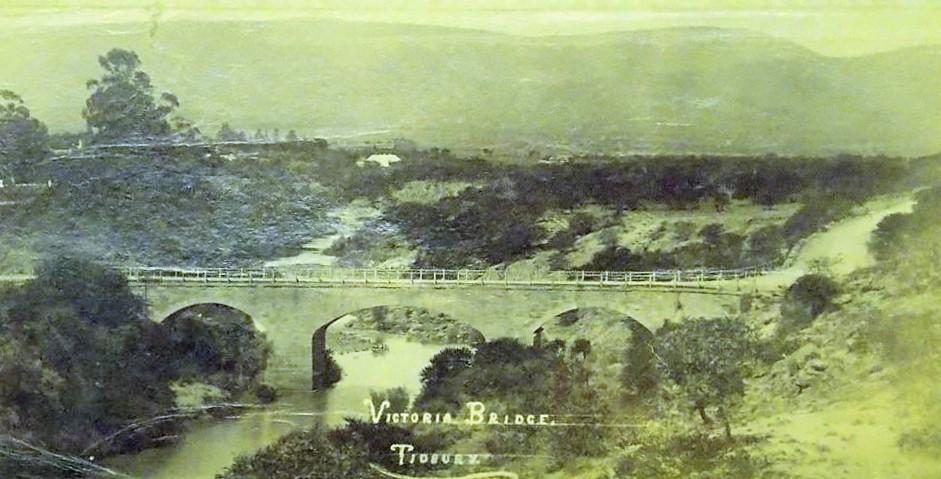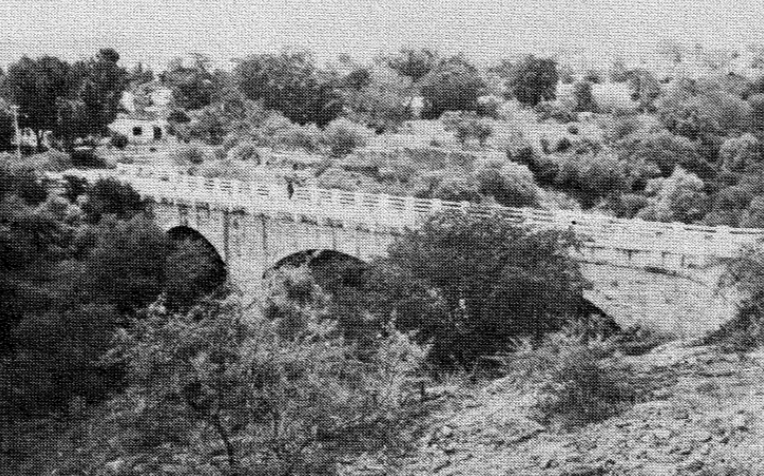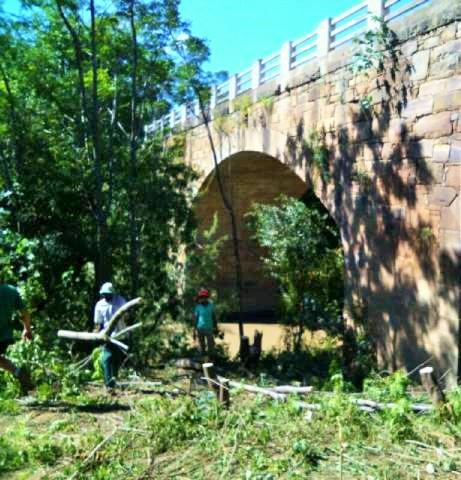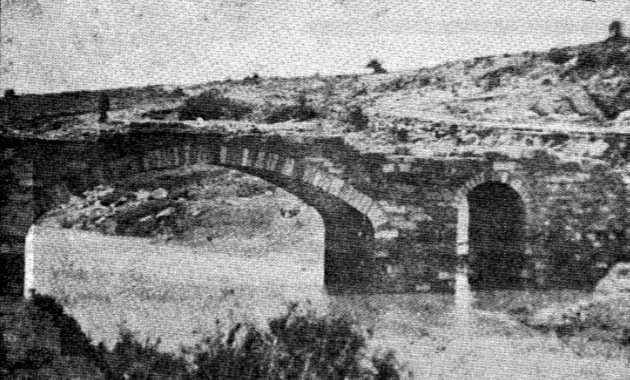
Disclaimer: Any views expressed by individuals and organisations are their own and do not in any way represent the views of The Heritage Portal. If you find any mistakes or historical inaccuracies, please contact the editor.
The following article on the history of the Victoria Bridge near Fort Beaufort appeared in the 1985 edition of Restorica, the old journal of the Simon van der Stel Foundation (today the Heritage Association of South Africa). Thank you to the University of Pretoria (copyright holders) for giving us permission to publish. Although the bridge is still in existence, local activists are concerned that it may not survive for long as it is being used by very heavy trucks and stress cracks have started to appear.
Spanning the Kat River on the margin of the built-up area of the town of Fort Beaufort in the Eastern Province, the Victoria Bridge is one of the very few early engineering structures of its kind still serving the purpose for which it was built.
This multiple span arch bridge was the first of three major bridges authorised by the Cape Colonial Government to improve lines of communications along the Eastern Frontier. These three bridges formed a vital link in the military road from Grahamstown to Fort Beaufort and onwards to Post Retief in the Winterberg, a distance of some 110km. Named the Queen's Road by a military order issued by the Governor of the Cape, Major-General Sir George Napier, its construction was undertaken by the Royal Engineers in the years 1837 to 1842. The road carried all traffic between the two towns until 1962 when it was superseded by the present truck road.
Credit for the design of the Victoria Bridge goes to Major C J Selwyn, commanding the Royal Engineers' Department in Grahamstown. There can be little doubt that Andrew Geddes Bain was entrusted with the supervision of its construction. Bain enlisted in the Royal Engineers in 1836 and when the military highway was commenced the following year, he was placed in charge of the working party. It was during this period until his discharge eight years later that he received his formal training as a road engineer and carried out his first major project in an official capacity.
Laying of the foundation stone
The ceremony of laying the foundation stone of the Victoria Bridge by Lady Napier, wife of the Governor, took place on 25th November 1840 in the presence of Sir George Napier. The Graham's Town Journal of 3rd December that year provides full cover of this historic occasion which was attended by the Lieutenant-Governor of the Eastern Province, Lt Col John Hare and his wife and many dignitaries:
Lady Napier supported on her left hand by the Lieutenant Governor and on the right by Major Selwyn, the head mason on the occasion, and followed by His Excellency the Governor and Mrs Hare, the staff and officers of the Garrison, then proceeded to the space allotted near the site of the foundation stone, where Lady Napier was conducted by Major Selwyn to a seat provided for her on which the band ceased playing.
Major Selwyn then addressed Lady Napier and the company assembled, in the following terms:
"Before your Ladyship proceeds with the ceremony of laying the foundation stone of this bridge, which His Excellency the Governor has been pleased to name the Victoria Bridge, in honour of our most gracious Queen, your Ladyship will permit me to express the high sense I entertain, as the officer entrusted with the execution of the work, of the honour you have conferred in gracing with your presence, and thereby adding a lustre and increased interest to the ceremony about to take place; and I am confident there are none here present who do not most cordially respond to these feelings. It will be gratifying to your Ladyship to learn that this day you will have laid the foundation stone of the first bridge of a permanent nature that has ever been thrown across any river of importance on our frontier possessions in Southern Africa, and it will be a day to be recorded in its annals, and especially of the town of Fort Beaufort as an era in its rising prosperity and improvement.
Without roads and bridges however great the riches and resources of a country may be, yet its commerce must languish, and the industry of its inhabitants become paralyzed, from the difficulty and uncertainty of transport of its produce, and its enhanced value, when at length it reaches a market. Roads and bridges are to a country, what the veins and arteries are to the human frame, by which the blood flows to, and from the heart, diffusing life and vigour throughout the system ...
With her Ladyship's permission we will, therefore, now proceed to lay the foundation stone of the Victoria Bridge, and altho' Fort Beaufort does not yet boast of a Free Masons' Lodge, yet on this auspicious occasion, as an old master mason, I have felt it a duty I owe to the craft, being kindly assisted by the brethren, to show our colours, and lay this stone with masonic honours."
Major Selwyn then gave a signal on which Mr Webb caused the upper stone to be raised, during which the band played a slow air, when it reached the height proposed, the band ceased playing, and the clergyman, the Rev G Booth, repeated a short prayer.
Lady Napier handed to Major Selwyn the plate, with the inscription, and the bottle with the coins etc. who handed them to Dr Forrest, to be deposited in the lower stone.
As soon as Dr Forrest had deposited these, three sapper masons and two of the 75th Regiment spread the mortar for bedding the stone, taking care to leave the space for the coins bare, and Lady Napier and Major Selwyn descended to the stone, and Mr Webb, the Foreman of Works, presented the trowel to Major Selwyn on a silk cushion, who handed it to Lady Napier.
An entered apprentice, Lieutenant G Napier, presented a hod of fine mortar to lady Napier, who spread it on that part of the stone where the inscription and coins were deposited.
Lady Napier then resumed her seat, and the Band played an air whilst the stone was lowering. When the stone had been properly placed Lady Napier and Major Selwyn again advanced to the stone, and Dr Forrest gave Major Selwyn the Square, Colonel Grieve the level, and Dr Anderson the plumb, which was presented by him to Lady Napier, who applied the square to the side of the stone, the level to the top, and the plumb to the angle; after having done so, she said, "I declare this work to be well formed, true, and trusty."
Dr Forrest, Colonel Grieve, and Dr Anderson then handed to Major Selwyn as he pronounced the last words of a prayer, the cornucopia, the wine and the oil.
Dr Courtnay then handed the mallet to major Selwyn, who presented it to Lady Napier, when her Ladyship knocked on the stone three times, and said, "I name this bridge the VICTORIA BRIDGE." The Guard of Honour then presented arms, and the band played God Save the Queen. A Royal Salute was then fired, and three cheers were given. Lady Napier then resumed her seat. The plan of the bridge was then presented to Major Selwyn, by Dr Forrest, for Lady Napier's approval, after which it was returned to Mr Webb with the other tools .. .'
Victoria Bridge 1969 (J V L Rennie in Restorica 1985)
First bridge across a river in Southern Africa
The bridge took about three years to build and comprised a central elliptical arch span of 20,7 m flanked by two small circular arch spans. It was a substantial structure in dressed masonry of good quality local sandstone with the piers and abutments founded on rock. The 4,9 m roadway crossed the river at a height of more than 10m above the river bed.
The Royal Engineers took the lead in spreading the use of cement in the Cape, the first consignment in barrels having been landed in Cape Town on 14 December 1838 from Holland. In the beginning its use was confined to hydraulic structures where durability and good workmanship were demanded, and for that reason 'Roman cement' was specified for the mortar of the Victoria Bridge.
Although no record could be found of the date the bridge was officially opened for traffic, the Graham's Town Journal of 14 September 1843 gives an account of the progress at that time: 'The Kat River, which nearly surrounds Fort Beaufort, was higher than has been known since 1823, and had it not been for the two bridges- one a beautiful structure, now building by the R E Department - Fort Beaufort would, on the colonial side, have been unapproachable.'
It is therefore clear that the river in full flood could already be crossed by the new bridge. The second bridge was in all probability a temporary crossing built for construction purposes. In a letter from Fort Beaufort dated 30 January 1845 'an elegant stone bridge' is listed among the amenities of the town. It is therefore reasonable to accept that it was opened for all traffic in late 1843 but certainly in 1844. Hence the claim that the oldest bridge across a river in southern Africa is to be found in the eastern Province. It is older than those across the Eerste River, Lourens River and Bot River in the western Province which were authorised by the Central Road Board and due to be opened on 1st July 1845.
A recent photo of a clean up around the bridge (Carl Kritzinger)
Flood damage
Thirty years after the Kat River had been bridged heavy floods disrupted communications over a wide area. In the report of the Chief Inspector of Public Works for the year 1874 it is stated that on the 6th December of that year much of the masonry above the voussoirs i.e. above the arches, had been swept away by the swollen river. Although the roadway was negotiable for light carriage traffic, within a few months permanent repairs were urgently needed. At the same time it was deemed necessary to provide more waterway and the work of reconstruction included widening the lateral arch spans to 13,7 m and 12,2 m. This was carried out on contract and completed in October 1876 at a cost of R9 800.
Victoria Bridge after great flood of Dec. 6 1874. Roadway and upper courses of masonry are damaged. Original photo In Fort Beaufort Museum
A close examination of a photograph of the bridge, displayed in the Fort Beaufort Museum, taken shortly after the flood reveals that the main structure withstood the onslaught of the flood waters. The central arch span and its supporting piers are original, only the flanking spans, have been widened and rebuilt. Unfortunately the foundation stone that had been so carefully laid by Lady Napier has disappeared and is probably buried deep in the mud where it will remain in obscurity.
Comments will load below. If for any reason none appear click here for some troubleshooting tips. If you would like to post a comment and need instructions click here.



